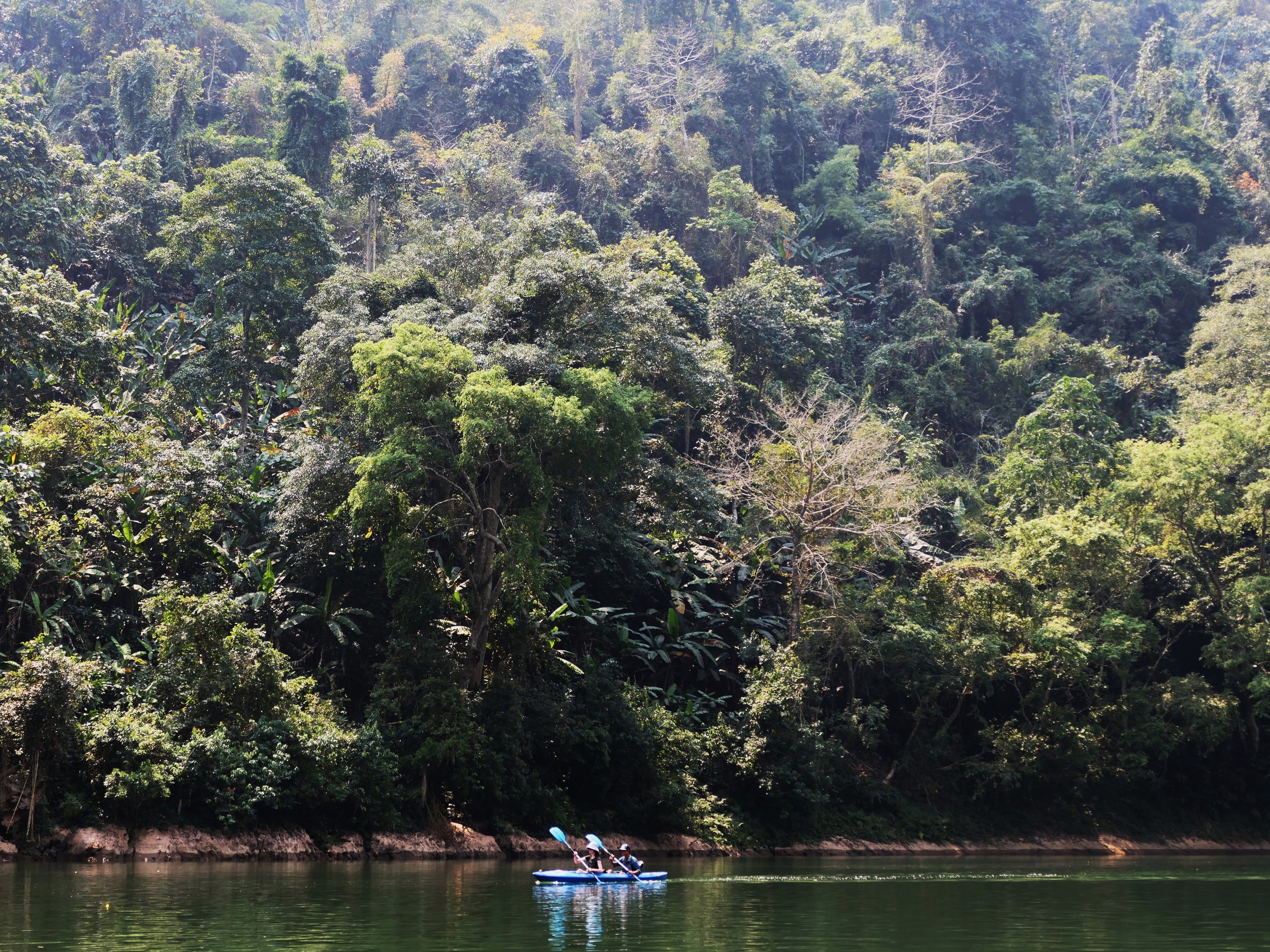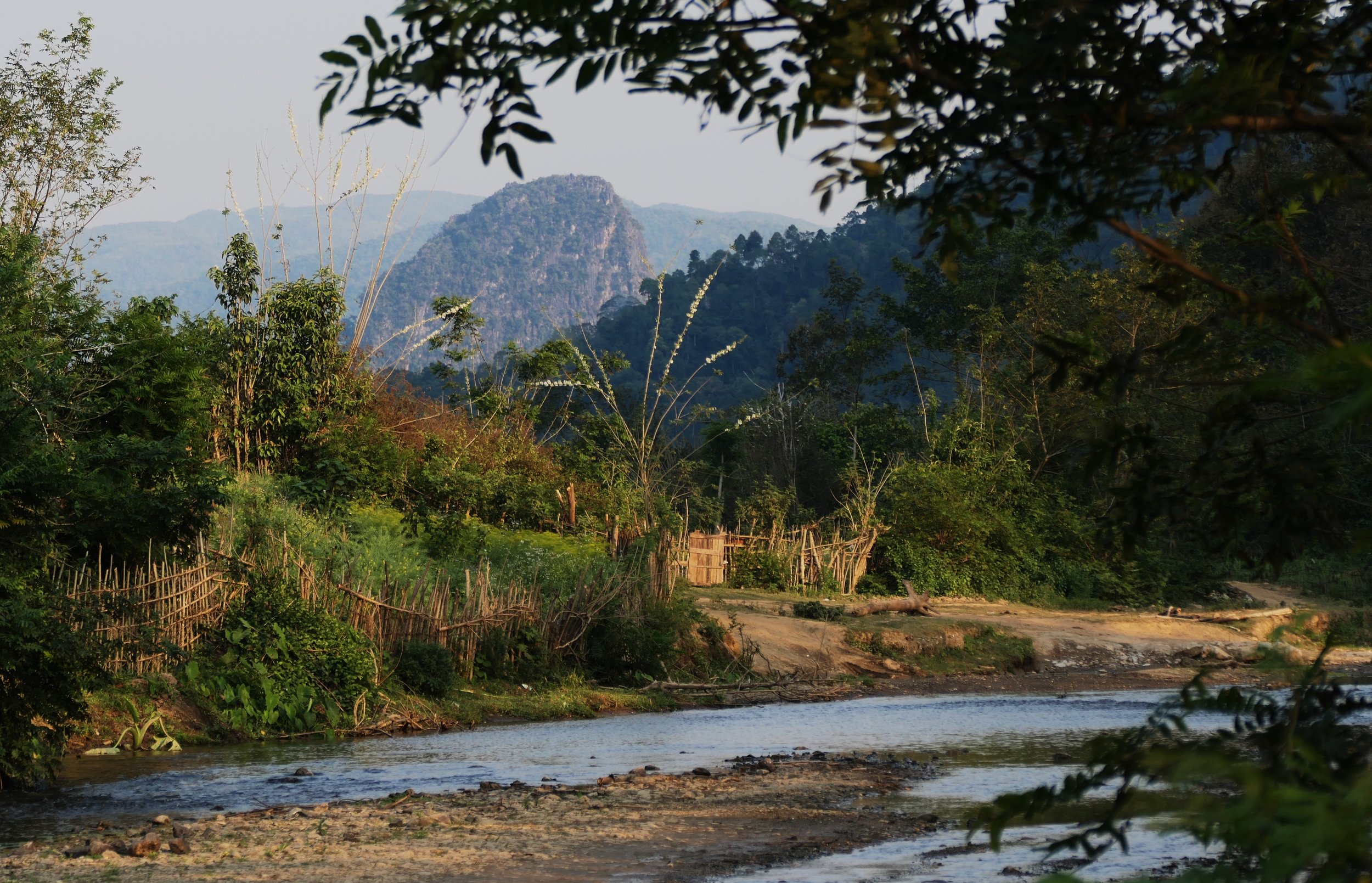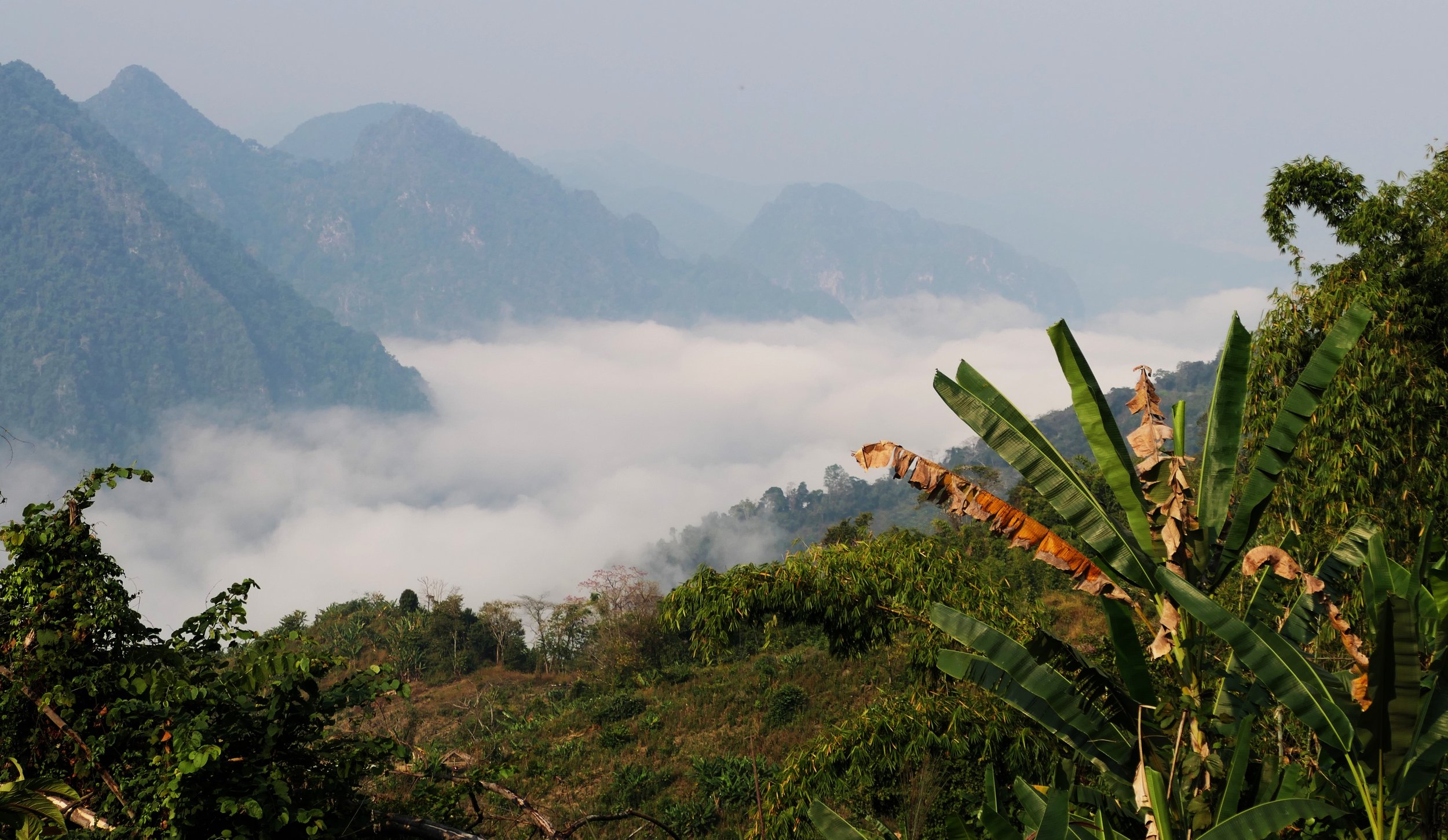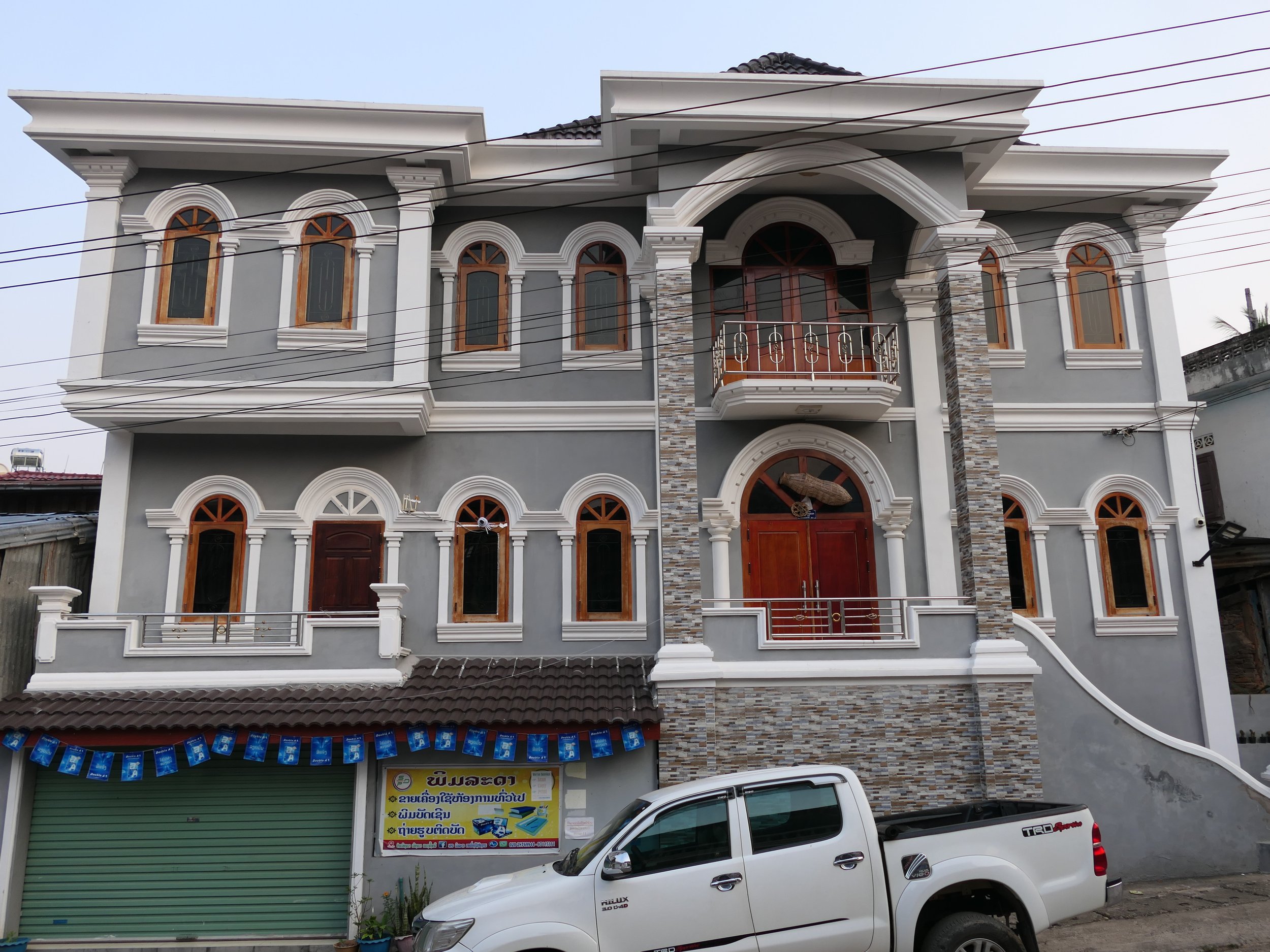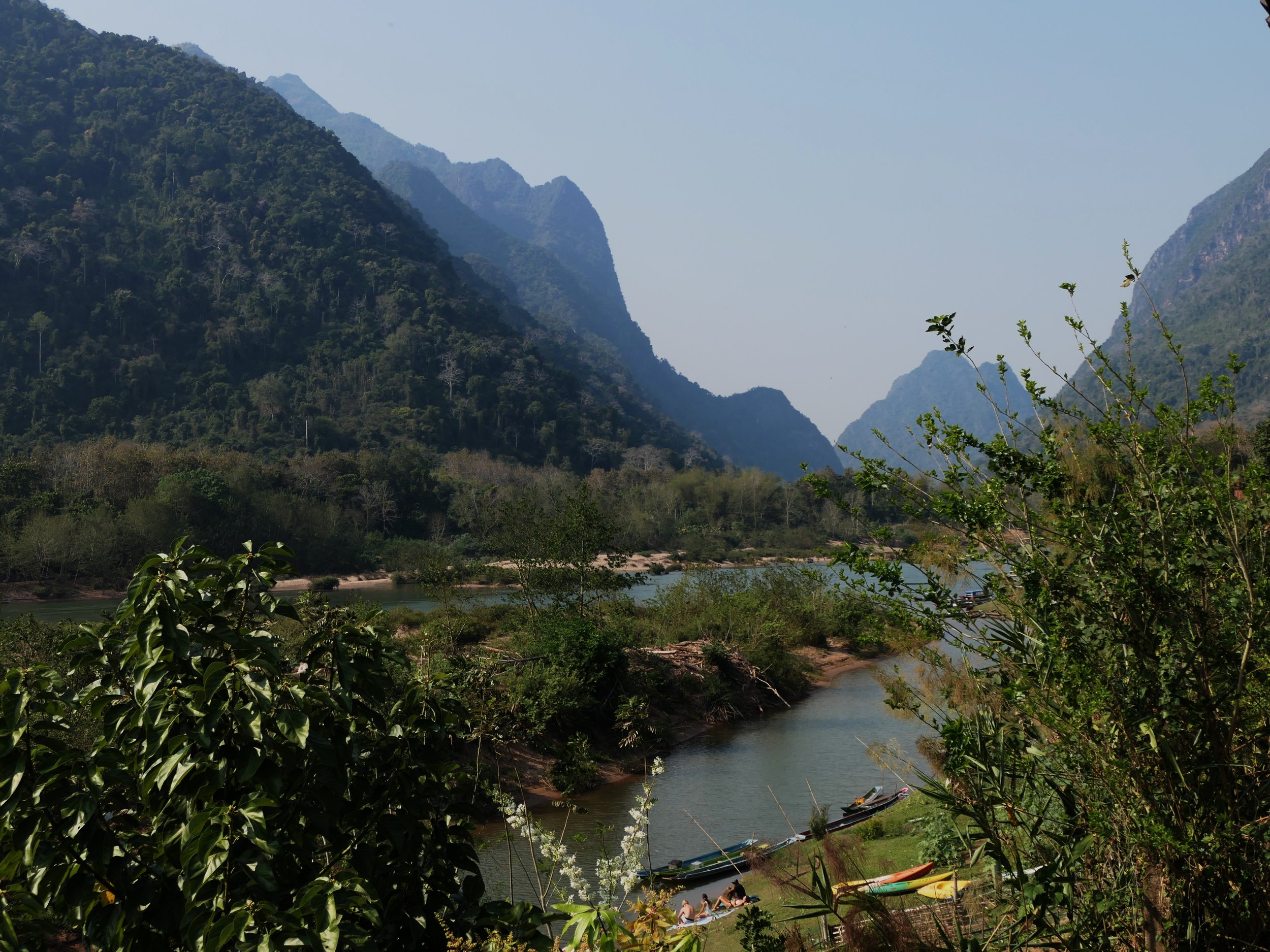
The gorgeous Ou River Valley: Nong Khiaw, Muang Ngoi, and Muang Khua
The Ou River is one of the 12 main tributaries of the Mekong. It holds some of the most beautiful scenery in all of Laos. If your time in Laos is really short, then besides Luang Prabang, the other place you must go is either Vang Vieng or here, to enjoy Laos’ stunning karst mountain scenery.
Vang Vieng is the better choice if (a) you are in a big rush, (b) you like loud party towns, (c) you don’t care about trekking and/or (d) you are heading to or coming from the South (Thakhek, Pakse, the 4,000 Islands and/or Cambodia).
But Nong Khiaw is definitely the better choice if (a) you have more time, (b) you prefer idyllic riverside villages to loud party towns, (c) you really want to go trekking and/or (d) you are going to or coming from the North (northern Laos, northern Thailand or northern Vietnam).
Nong Khiaw is the 2nd-best place to trek in all of Laos, and it’s not too far from the absolute best place to trek (Luang Namtha).
Getting there and around by bus and boat
Nong Khiaw has good bus connections to/from Luang Prabang: 4 very bumpy hours, cost as of January 2025 is 120,000 kip (5.500) just for the intercity bus, or 170,000 including the tuk-tuk between Luang Prabang’s North Bus Station and the city centre. Scheduled buses depart Luang Prabang’s northern bus station (7 km north of the centre near the airport) at 08:30, 10:30 and 12:30. More conveniently, a minivan departs from the much more central Naluang bus station (on Google Maps) at 09:00, and additional minivans depart from several places in town throughout the day. Some minivans go on a schedule, some depart whenever they fill up. Some will pick you up right at your hotel, some won’t (if it does this, you may spend a long time driving around Luang Prabang picking passengers up, before you even leave town). This usually costs 200-250,000 kip. Like the bus, minivans are usually very crowded — board early and take a seat toward the front of the vehicle if possible, for a smoother ride. Or you can take a private car for $100-150 each way. Private drivers will approach you every 2 minutes, all over Laos — always get multiple price quotes.
As everywhere in Laos, most buses on this route are not listed on the internet at all. 12Go is useless in Laos. Book locally, on arrival, within 24 hours of your departure time. Book at the station, through your guesthouse, or through the travel desk at Tony’s Central Hostel in Luang Prabang.
There are also good bus connections between Nong Khiaw and Luang Namtha (7-8 hours, once per day, stopping en route in Muang Xay / Oudomxay).
At least once per day at 11 AM, boats make the 1-hour trip from Nong Khiaw to the gorgeous, roadless village of Muang Ngoi. And most days (if there are at least 5 paying passengers) the boat will go further, making the full-day trip all the way between Nong Khiaw and Muang Khua which is the gateway to northern Vietnam. As of December 2024 going all the way to Muang Khua costs 350,000 kip per person. Nong Khiaw’s boat ticket office on the riverbank has all the information. Note that when travelling between Muang Ngoi and Muang Khua, you and your luggage will have to exit the boat at one point to walk around a dam.
If coming to this region from Vietnam (whether coming from Hanoi, Sapa, or almost anywhere else) you will change buses in Dien Bien Phu, and enter Laos at the Tay Trang border crossing. Several buses every day go from Dien Bien Phu via Tay Trang to Muang Khua, many continuing onward to Oudomxay, Phongsali, Luang Namtha, or elsewhere in northern Laos. All nationalities can use the Tay Trang crossing, but if your nationality requires a visa, then you MUST get it in advance at the Lao consulate in Hanoi — Lao e-visa and visa on arrival are NOT accepted here. See here for more info on Laos visas.
To get from Luang Prabang to Muang Ngoi in one day, book the shared minivan that picks you up at your hotel in Luang Prabang around 8:30am and arrives at Nong Khiaw bus station around 13:00. There you take a tuk tuk across town to the pier, where on most days a second boat departs to Muang Ngoi at 2 PM, arriving Muang Ngoi at 3 pm (this boat does not continue on to Muang Khua). As of February 2024, I am told that the Khoun Phet guesthouse in Luang Prabang will book this itinerary for 150,000 kip, which is only a few dollars more than booking the bus and boat separately. And, Khoun Phet should know on which days there is a 2 PM boat — on some days there is only one boat a day, usually departing Nong Khiaw at 11 AM. But if you arrive in Nong Khiaw at 1 PM, and there is no afternoon boat that day, and you have to stay overnight in Nong Khiaw, that’s really no bad thing at all. See below for how to spend your time.
You may have heard reports of boats being stopped due to low water levels. The water level depends heavily on how much water is being released from the Chinese dams upstream — this can change significantly from hour to hour. The boats can run in very shallow water, and they will go if at all possible. Sometimes the heaviest men will need to get out of the boat and walk in the river for a bit, or even help push the boat off of sand bars. So, wear sandals or flip-flops, and if you are travlling downstream, hang on tight to the side of the boat when pushing it, so you can haul yourself back in and not watch the boat go flying down the river without you. (They would stop for you in that case, obviously, but it’s fun to haul yourself back in just as the boat is flying away!).
Nong Khiaw
Nong Khiaw town is small and easily walkable, with several good restaurants. Renting a bicycle is nice for an easy, level, ride to the west, along the river. A motorbike is better if you want to go east, up into the mountains (with only one paved road, you can’t get lost). You can also ride a dirt road north along the eastern bank of the river to Ban Hat Sao village – this is easy on a motorbike, strenuous on a bicycle in the soft sand. It’s so short a distance, but Ban Hat Sao is a very different world than Nong Khiaw. I particularly recommend this if you won’t do any trekking.
Absolutely, positively visit the Phatok Caves on the main highway at the eastern edge of town, where the Pathet Lao Communist guerrillas ran the regional war effort while the US was relentlessly bombing the town and the surrounding agricultural fields. When you’re tired from all the hiking, have a massage at Sabai Sabai on the main highway just across the bridge from the town centre.
Nong Khiaw has three mountain overlooks that are all good, especially at sunset:
On the north side of the highway, on the eastern riverbank, you’ll see a big sign for the Xom Nang Viewpoint (on Google Maps it’s just called the Nong Khiaw Viewpoint). This is the easiest of the three to climb, with a well-graded trail and handrails.
Just across the road from Xom Nang is the Phanoy viewpoint. This is the highest and the most difficult climb. Bring bedding, stay the night under the canopy up there, and enjoy waking up above the morning mist the next day – views are incredible. Or a $25 overnight tour includes dinner, water, bedding, and breakfast.
The third one (shown in the picture) is Sleeping Lady viewpoint. The trailhead is on the main highway close to the bus station, at the western end of town.
Trekking in Nong Khiaw:
The best trekking in Laos is in Luang Namtha 7-8 hours’ bus ride away in far northwestern Laos. The jungle up there is far less deforested. But if you don’t have time for a 3-day trek in Luang Namtha, then Nong Khiaw is your 2nd-best option for trekking.
The guiding agencies are all located in the centre of town, near the bridge. I personally went with NK Tiger Tours and had a good experience. I know of one person who went with Nongkhiaw Experience Tour and found it very badly overcrowded (50 people in the group, which is insane) and badly organised. All the agencies offer 2-day treks with one night in a tribal village, which is very popular and easy to book — if you are a solo traveller, you will have no trouble joining a group to make it cost-effective. This can be extended to 2 nights and 3 days which is much less popular, but worthwhile and cost-effective if at least 2 people want to do it. The 3-day itineraries normally include Sopchem, and with that a boat ride between Sopchem and Muang Ngoi which may be the most beautiful stretch of river in all of Indochina. All hikes out of Nong Khiaw go through a lot of barren, deforested areas, but you will also have some really beautiful and fun moments.
Ban Anoulak Cultural Preservation Village
Located about an hour’s drive northwest of Nong Khiaw, and an hour’s drive northeast of Pak Mong (10 km north of the main highway 1C on which the Luang Prabang - Nong Khiaw buses run), Ban Anoulak Cultural Preservation Village is a Tai Lue ethnic village in Ban Nayangtai, Nambak District. The Tai Lue are an ethnically Thai tribe of about 700,000 people scattered widely across Indochina and neighbouring areas. Here you will stay in a traditional Tai Lue wooden house, experience local crafts, and learn about tribal culture. Although you can book this through most internet booking sites, I suggest cutting out these middlemen with their fat commissions by contacting the village directly on +856 20 55 004 665 or Kbounthiphanh@gmail.com. Check out their Facebook page for more info, here.
Muang Ngoi
Getting from Nong Khiaw to Muang Ngoi:
Boats make the one-hour trip from Nong Khiaw to the gorgeous, idyllic, roadless village of Muang Ngoi every morning. (Note: When the river is too low for boats to travel, you can get there via a very rough dirt road — much less pleasant but do-able. Check for the latest updates on Facebook sites like “Travelling in Laos” and “Laos Backpacking”).
When you arrive, you can walk through Muang Ngoi in half an hour, but stay for at least one night and more if you can. Enjoy the stunningly beautiful riverside mountain setting, with cheap, comfortable lodging and good restaurants. And do the short climbs to at least one of the overlooks at the northern and southern ends of town, as well as the short excursions from town if you like (see below).
Several restaurants in Muang Ngoi serve great lunches and dinners. The best breakfast is the sumptuous buffet at Phetdavanh Restaurant in the town centre near the boat dock, owned by Gabriel from Sweden, his Lao wife Penny and their 5 kids. Gabriel and Penny also run two good guesthouses, Sunset Bungalows and Riverview Bungalows. Gabriel’s story of how he came to Laos and never left is well worth hearing. And if you bring a guitar, he will be delighted to get his guitar and jam with you.
Like all of Laos, the Ou River Valley has suffered badly from deforestation. The most beautiful, undamaged stretch of the Ou river is between Muang Ngoi and the silk-producing village of Sopchem a short distance north. It’s well worth taking the frequent “Silk Village” boat tour from Muang Ngoi to Sopchem even if you don’t like silk, just to see that stunning stretch of river (see picture of the kayakers). The best time for photography is late morning / early afternoon, when the sun glances off the steep cliffs and shines deep down into the valley.
Trekking and touring in Muang Ngoi
When I first visited Muang Ngoi in 2006, I found it so magical that I wrote a song about it. If you’re interested, it’s here.
In 2006 the village only had electricity 3 hours a day, and you couldn’t wander too far outside of town because of unexploded American bombs. Now, 24-hour electricity and internet are here, and the bombs have been cleared. And you can do an easy, level, self-guided half-day trek through the Ngoi river valley to Ban Na and two other ethnic villages a few miles from the river. It’s a little touristy but pleasant.
Several short trips by boat are worth doing: you can hire a boat with driver to take you to your own private stretch of the Ou River for swimming and a picnic, or take a short boat ride to a short hike to Tad Mook Waterfall and Yensabai Organic Farm. You can also stay overnight at the farm if you book in advance (http://yensabaiorganicfarm.com/).
A 2-day guided trek is offered to a mountaintop village called Ban Khiewkhanh. There are some great things about it, but the short day hikes from Nong Khiaw are better, and multi-day hikes are better elsewhere. There is too much deforestation on this hike, and the village where you stay overnight is actually a government-planned “new” community whose layout seems designed to discourage social interaction. What was once a thriving community prior to 2012 now feels like a ghost town. Anyone who did this hike before 2012 (as I did) will tell you this hike is magical, and it was.
These days, the best things about this hike are at the end: on day 2, if you start hiking early enough, you’ll get an amazing hilltop view standing above the morning mist before it burns away around 10 AM. And, the hike ends in Sopchem. From there you come back to Muang Ngoi by kayak or motorboat on the most beautiful stretch of the Ou river.
Muang Khua – gateway between northern Laos and northern Vietnam (updated April 2023)
Now that the Chinese have dammed the Ou River in many places to produce electricity, the only navigable part of the Ou river is between Nong Khiaw-Muang Ngoi-Muang Khua. Boats between Nong Khiaw and Muang Ngoi go at least once a day; boats to and from Muang Khua usually go every 1-2 days. Occasionally, low water levels stops all boats for a day or two — late in the dry season and/or when too little water is released from the dams upstream. Sometimes the boats are going but you must be prepared to repeatedly jump in the very shallow river and help push the boat off of sand bars. The Tourist Information Centre should know the schedule, and your guesthouse staff might know. You can also ask on Laos travel websites on Facebook.
Muang Khua is a small, pleasant town, but most people only stay long enough to transfer between boats and buses, and to print out their Vietnamese e-visas if they need to do that. From here you can easily go to northern Vietnam, or via boat to beautiful Muang Ngoi and Nong Khiaw, or the via bus to Luang Namtha which has the best trekking in the country.
This is a rare town where the government-run Tourist Office has reopened post-Covid, and they advertise several treks, but I didn’t try any. If you have trekked in Muang Khua, please tell me about it.
If you are planning to come to Muang Khua from Dien Bien Phu in Vietnam via the Tay Trang border crossing, note that neither the Lao Visa on Arrival nor eVisa are available at this border. You MUST get a visa in person at the Lao consulate in Hanoi or another country before you come.
If you are going from Muang Khua into Vietnam, and you have a Vietnamese e-visa, you should print out your e-visa BEFORE arriving at the border. Sometimes just having it on your phone is enough, but not always. I found ONE place in Muang Khua that will do this, in the basement of the building in this photograph. Located across the street from the Chalern Souk guesthouse (a good place to stay), they open at 17:00 and close about 5-10 minutes later. Don’t be late!
Buses stop on a streetside in the centre of town – on Google Maps, look for” Bus station Nam Phak Bridge, Muang Khua, Laos”. Each morning, a bus leaves at about 08:00 AM to the Vietnamese border and then to Dien Bien Phu. Get here by 7:15 to buy your ticket and secure a seat towards the front of the bus, where it is less bumpy. If you miss the 08:00 AM bus, other buses will pass through later in the day en route to Dien Bien Phu, but they start in Phongsali or Oudomxay or Luang Namtha and you never really know when they will arrive in Muang Khua. So it’s better to go in the morning.
Travel tip for those going to Vietnam: The bus station in Dien Bien Phu is several miles north of town. Before arriving at the station, the bus from Laos usually stops to let people off on a little street in the city center called Lò Văn Hặc. If you’re planning to stay in Diejn Bien Phu overnight, it’s more convenient to get off here, not ride all the way to the bus station.
Continuing on from Dien Bien Phu, several buses depart at around mid-day or early afternoon for Sa Pa and Lao Cai. Buses to Hanoi go overnight, departing frequently between 17:00 and 22:00. ALWAYS buy your bus ticket from the ticket kiosk inside the station. Sometimes touts willt ry to see tickets outside the station, but then you don’t know what you’re getting.
On Lò Văn Hặc street in central Dien Bien Phu, inside Frontier Hostel, is a tour agency that runs an excellent one-day tour of Dien Bien Phu Battlefield – you’ll visit the French trenches in the city centre (it was just a village then) as well as the North Vietnamese jungle HQ and the incredible artillery emplacements that the Viet Minh hacked into the steep jungle to pound the French into surrender. The motorbike ride out into the hill country of the Black Tai tribe is beautiful, both for the mountains and the architecture (you can also go via tuk-tuk or taxi.) This is the place where the age of European colonialism ended and the age of superpower proxy wars began. It’s really worth a day of your time.
You can do this tour and then catch a night bus to Hanoi. Or if you are travelling to Sa Pa or Lao Cai, then you’ll need to stay two nights in Dien Bien Phu to do this tour, and catch the day bus the following day around 11:00 or 12:00 noon.


